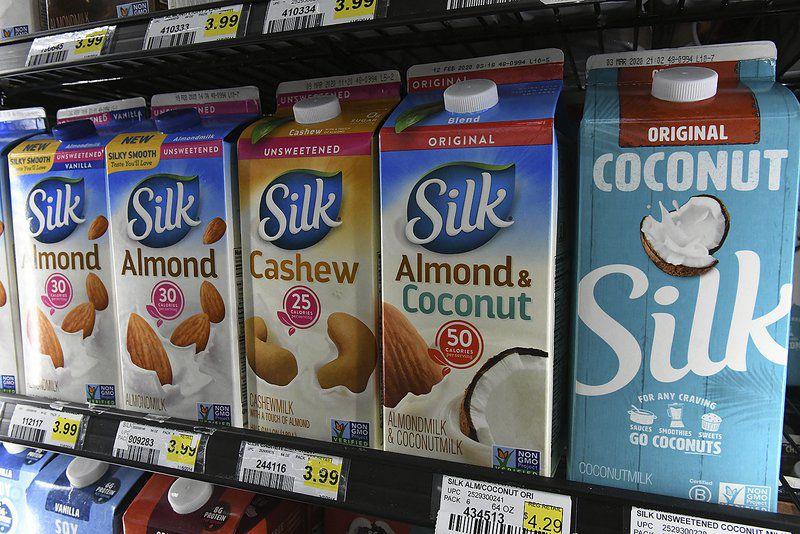39 reading labels for lactose intolerance
PDF Managing Lactose Intolerance Managing Lactose Intolerance What is Lactose and Lactose Intolerance? Lactose is a sugar found in some dairy products. Lactase is an enzyme in the ... plan to use one of these, be sure to read the nutrition labels carefully and choose a brand that specifically states it contains calcium and vitamin D. The Understanding Food Labels - Go Dairy Free Food labels can be confusing, especially when special diets and food allergies come into play. ... recommendations and health guides to aide those with milk allergies, lactose intolerance or a general need or desire to live without dairy. Dairy-free does include milk-free, lactose-free, casein-free and whey-free, too! We also offer ample ...
PDF A Guide to Managing Milk Allergy November 2021 - Kids With Food Allergies This includes all milk products, as well as lactose-free versions of milk products. Milk allergy is different than lactose intolerance (an inability to digest the milk sugar known as lactose). ... • Reading labels • Being aware of cross-contact (when foods come into contact with each other and may transfer
Reading labels for lactose intolerance
Lactose Intolerance | Patient Education | UCSF Health Lactose, a milk sugar, is found primarily in dairy products. It also may be added to foods during manufacturing. Intolerance to lactose is caused by a lack of lactase, an enzyme that breaks down lactose for digestion. Some people produce low amounts of lactase under normal conditions. In general, African-American, Asian and Native American ... Label Reading & the FDA | Celiac Disease Foundation The Celiac Disease Foundation Medical Advisory Board supports the <20 ppm of gluten standard for gluten-free labeling. According to Dr. Peter Green, Director of the Celiac Disease Center at Columbia University, "The 20 ppm is a scientifically determined level of gluten that has been shown to be tolerated by those with celiac disease. Lactose Intolerance - Academy of Nutrition and Dietetics Lactose intolerance is a problem digesting foods that contain lactose. Lactose is a naturally occurring sugar found in dairy products such as milk, yogurt and cheese. Many people are able to have these foods and beverages without problem, but some individuals are unable to break this sugar down. Lactose intolerance runs in families—thus if ...
Reading labels for lactose intolerance. Does Havarti Cheese Have Lactose - CheeseProClub.com Lactose intolerance occurs when your small intestine doesn't produce enough of an enzyme to digest milk sugar . Normally, lactase turns milk sugar into two simple sugars glucose and galactose which are absorbed into the bloodstream through the intestinal lining. Lactose Intolerance: Symptoms, Diagnosis & Treatments How do I know if processed foods contain lactose? When buying food, read the ingredients on food labels carefully. Ingredients derived from milk that contain lactose include: Whey. Cheese. Milk by-products. Dry milk solids. Lactose. Butter. Curds. Nonfat dry milk. Dry milk powder. Also avoid items that state "may contain milk" on the food label. Lactose Intolerance - UW Medicine Health Library Lactose intolerance is when your body can't break down or digest lactose. Lactose is a sugar found in milk and milk products. Read on to learn details about lactose intolerance, including causes, symptoms, diagnosis, and treatments. ... It's important to read food labels. Lactose is often added to some boxed, canned, frozen, and prepared ... Lactose Intolerance: Symptoms, Treatment, Calcium Sources Most people with lactose intolerance can tolerate 12 grams of lactose in one sitting, but up to 18 grams if spread throughout the day. Read nutrition labels. If you get symptoms after consuming even small amounts of lactose, you should always read nutrition labels.
Fast Five Quiz: Lactose Intolerance - Medscape Patients should read labels on commercial products. Patients should avoid or reduce intake of lactose-containing foods. Most patients who are lactose intolerant can ingest as much as 240 mL of milk... Lactose Intolerance | University Hospitals Lactose is a sugar found in milk and milk products. Lactose intolerance is not the same as having a food allergy to milk. It happens when you don't have enough of an enzyme called lactase. Lactase breaks down lactose in food. The most common symptoms of lactose intolerance are belly cramps and pain, nausea, bloating, gas, and diarrhea. Lactose intolerance - foods to eat and foods to avoid - Medicine.com added calcium or vitamin D labeled food or drinks Foods to avoid if you have lactose intolerance Milk and milk products are listed on product labels in a variety of ways. These ingredients should be avoided if they exacerbate your symptoms of lactose intolerance. Always read the labels before purchasing an item. Ingredients to look for: whey milk Lactose Intolerance Lactose intolerance is when your body can't break down or digest lactose. Lactose is a sugar found in milk and milk products. Lactose intolerance is not the same as having a food allergy to milk. It happens when you don't have enough of an enzyme called lactase. Lactase breaks down lactose in food.
Lactose Intolerance | HealthLink BC Lactose intolerance means the body cannot easily digest lactose, a type of natural sugar found in milk and dairy products. This is not the same thing as a food allergy to milk. When lactose moves through the large intestine (colon) without being properly digested, it can cause uncomfortable symptoms such as gas, belly pain, and bloating. Reading food labels to avoid food allergies and intolerances Reading food labels to avoid food allergies and intolerances In Australia all packaged foods must include a food label. Food labelling is governed by Food Standards Australia New Zealand (FSANZ). Nutrition information is found in two places on a food label: the ingredient list and the nutrition information panel. Sample food label Lactose Intolerance | Symptoms and Tests | Patient Lactose intolerance symptoms. You may get bloating, or stomach pains. Excessive burping or passing a lot of wind can occur. You may also get watery diarrhoea, and itching around your bottom (anus). These symptoms tend to develop from one to several hours after milk, dairy products or any food containing lactose. PDF Your quick guide to: Lactose Intolerance - Allergy UK Diagnosis of lactose intolerance is usually made if the symptoms get better after excluding all sources of lactose from the diet for two weeks and this involves carefully reading food labels. Lactose rich foods are then re-introduced into the diet and if the symptoms come back, the diagnosis is confirmed.
Learning To Find The Lactose: A Label Reading & Recipe Swap Tutorial For Newbies | FODMAP Friendly
The Secrets to Decoding Food Labels for Dairy-Free Living May 11, 2020 · Milk-Free – It’s typically equivalent to dairy-free labels, and should mean the product is made without any milk-based (dairy) ingredients. Lactose-Free – Lactose-free just means the product is free of milk sugar, not of all milk-based ingredients. However, some dairy-free products use this label instead of dairy-free. We’re not sure why.

14 best Lactose Intolerance Specialist Beverly Hills images on Pinterest | Lactose intolerance ...
Lactose intolerance - AGA GI Patient Center Label reading Lactose-free dairy products (Lactaid milk, lactose-free yogurts, hard cheeses) are made from real dairy and have been treated to reduce the lactose content of the product. Dairy-free products are made from plants, such as nuts or grains (e.g., almond, coconut, soy, oat) and are naturally lactose-free.
National Center for Biotechnology Information Labeling of allergens:There are particularly strict regulations concerning the labeling of the main ingredients that can cause allergies or sensitive reactions. Currently, 14 substances and products must be labeled as potential allergens. These include things like soy, wheat, eggs, milk, peanuts, almonds and walnuts.

Tips for Avoiding Milk and Reading Labels for #MilkAllergy #foodallergy | Dairy free diet, Dairy ...
PDF My Nutrition Lactose intolerance - Queensland Health • Check food/drink labels to identify any added milk or milk products. Milk proteins, ... reading the nutrition information panel. • Have 2-3 serves of dairy/dairy alternatives per day. This may be different depending ... • If you have lactose intolerance, you may be at risk of not getting enough calcium. ...
Shopping tips for lactose-intolerant people | informedhealth.org Jan 25, 2022 — When trying to avoid lactose, it is helpful to read the ingredients listed on food labels. These lists tell you whether the product has ...
Reading food labels - Food Allergy Education How to read food labels that meet the new PEAL law Under the new PEAL law, common food allergens are to be listed with the plain English name alongside the actual ingredient name. This is shown in the label example below. In the statement of ingredients, declarations must: Be in bold font. Have bold font contrasting distinctly with other text.
Dairy-Free: How to read food labels May 26, 2019 · NOTE re lactose: Lactose = milk sugar and does not contain the protein however there can be some contamination with milk protein. Lactose in medications is considered safe. This requires the consumer (= you) to know that any of these words when checking a food product is dairy free.
Lactose Intolerance (for Teens) - Seattle Children's Hospital Lactose intolerance is when someone has trouble digesting lactose, a type of sugar found in milk and other dairy foods. If people with lactose intolerance eat dairy products, the lactose from these foods pass into their intestines, which can lead to gas, cramps, a bloated feeling, and diarrhea. Some people can have small amounts of dairy ...
Things to Know About Lactose-Free FDA Labels Apr 06, 2018 · Lactose-Free FDA Labels Since lactose intolerance is not an actual allergy (like a milk, egg, or wheat allergy), there is no FDA definition for lactose-free. However, manufacturers must always be truthful with their ingredients and if a product contains lactose, they must say so on the product label.
16171--Managing Lactose Intolerance (patient handout view) Cultured yogurt (check labels for "contains live cultures") Hard cheeses (e.g., Swiss, cheddar, Parmesan) Butter Lactose-free milk (e.g., Lactaid ® or store brand equivalent) If you wish to drink regular milk, try taking a little at a time (like ½ cup).
Lactose Intolerance | Allergy UK | National Charity Diagnosis of lactose intolerance is usually made if the symptoms get better after excluding all sources of lactose from the diet for two weeks and this involves carefully reading food labels. Lactose rich foods are then re-introduced into the diet and if the symptoms come back, the diagnosis is confirmed.
Allergens: Understanding Dairy Product Labels - Food Safety ... Jul 21, 2020 — Items labeled as just lactose free, however, might be entirely derived from animal milk! What does it mean for a product to be dairy-free? If a ...
Lactose Intolerance - Academy of Nutrition and Dietetics Lactose intolerance is a problem digesting foods that contain lactose. Lactose is a naturally occurring sugar found in dairy products such as milk, yogurt and cheese. Many people are able to have these foods and beverages without problem, but some individuals are unable to break this sugar down. Lactose intolerance runs in families—thus if ...
[Solved] Lactose intolerance causes difficulty digesting dairy products that contain lactose ...
Label Reading & the FDA | Celiac Disease Foundation The Celiac Disease Foundation Medical Advisory Board supports the <20 ppm of gluten standard for gluten-free labeling. According to Dr. Peter Green, Director of the Celiac Disease Center at Columbia University, "The 20 ppm is a scientifically determined level of gluten that has been shown to be tolerated by those with celiac disease.
Lactose Intolerance | Patient Education | UCSF Health Lactose, a milk sugar, is found primarily in dairy products. It also may be added to foods during manufacturing. Intolerance to lactose is caused by a lack of lactase, an enzyme that breaks down lactose for digestion. Some people produce low amounts of lactase under normal conditions. In general, African-American, Asian and Native American ...












Post a Comment for "39 reading labels for lactose intolerance"